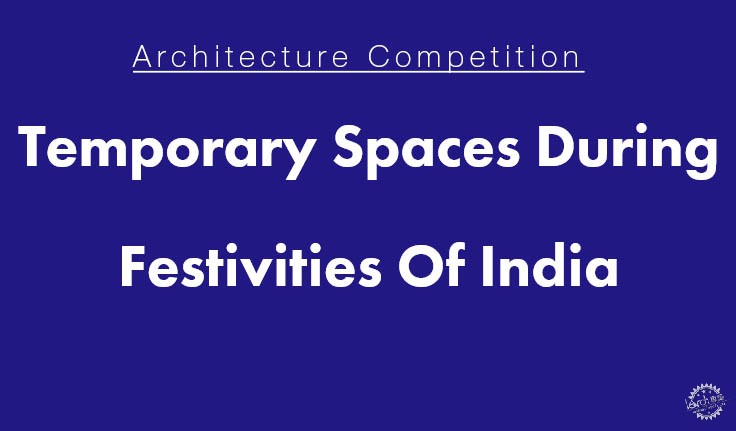
Temporary Spaces during Festivities of India- Architecture Design Competition
由专筑网缕夕,李韧编译
提交日期:2019年7月11日
注册日期:2019年7月10日
语言:英语
地点:印度
奖励:请参阅以下详细信息
类型:开放型
印度拥有许多缤纷色彩的传统节日,当地的文化、语言、信仰和节庆活动多种多样。有些节日仅因当地环境、社区和地理位置存在,还有一些在全国各地都很常见的节日,但在不同的地方以不同的方式来庆祝。
节日是传播宗教信仰的无形手段,维持祖传习俗,并改善社会生活条件。这也意味着人们要从日常工作中休息,与他人互动,提高情感联系,留下珍贵的记忆。
在不同的空间里感受不同的节庆活动,Ganesh Chaturthi在全国各地中都有许多活动,Rann、Hornbill和Pushkar Mela等节日都受到地理位置的限制。由于节庆活动会导致人流量临时增加,因此需要建造一些临时活动空间,用于提供设施或开展相关活动。虽然大多数时候这些空间不是由大师设计,但它们的设计同样需要遵循设计原则,有效利用空间。
机遇
虽然节庆活动期间创造的临时空间有着当地影响力,但这些作品也会随着可用的资源和技术进步而转变。因此,参赛者需遵循地方人民和节日的历史、文化和宗教的重要性,并利用合理的材料和技术。如何设计临时节庆活动空间?如何增加空间价值、增强城市的氛围形象?如何通过安全、经济的解决方案,利用空间体验唤起情感?
挑战
竞赛针对特定位置和背景设计特定节日的临时空间。它涉及节日的历史相关性、象征意义、目的、时间限制、当地可用材料、气候考虑因素、技术以及对生态系统的影响。设计的临时空间可以用于任何节庆活动,使用规模不限。设计作品不应该是既有方案,但可以从中受到启发,再进行调整与修改。
作品提交要求
1. 提交时应遵循以下规则。
2. 在限定日期内提交。
3. 按照上述要求提交最多4张A2图幅的文件。
4. 不允许在表格上显示姓名或任何其他身份证明,仅标识官方ID码。
5. 任何与JURORS或组委会有联系的参赛者将取消参赛资格。
时间安排:
竞赛开始日期:2019年3月27日
提前注册开始日期:2019年3月27日
提前注册结束日期:2019年4月15日
正式注册开始日期:2019年4月16日
正式注册结束日期:2019年5月26日
最迟注册开始日期:2019年5月27日
最迟注册结束日期:2019年7月10日
作品提交截止日期:2019年7月11日
获奖名单公告日期:2019年7月31日
注册费用
学生:
提早注册:350卢比
正式注册:500卢比
最迟注册:750卢比
专业人士:
提早注册:1350卢比
正式注册:1500卢比
最迟注册:1750卢比
奖励
一等奖:50000卢比+获奖证书
二等奖(2名):25000卢比+获奖证书
三等奖(3名):10000卢比+获奖证书
10名荣誉奖:获奖证书
参赛资格
● 欢迎学生和专业人士参赛。年龄限制18-35周岁。
● 每个团队最多4名成员,其中至少有1名成员为建筑学专业。
● 参赛者可以提交多个方案,但每个方案都需要单独注册。
● 所有学生参赛者必须提供有效的身份证明。队伍里只要有一名专业参赛者,也将归入专业团队。
● 任何形式的抄袭都可能取消参赛资格,剽窃的作品会在门户网站上公开宣布。
● Acharya Institutes / Jury会员/策展人或任何与他们相关的人员不得参加竞赛。
● 竞赛不限国籍。Acharya Institutes保留修改竞赛日程的权利。
竞赛网站:https://acharya.ac.in/architecture_event
Submission: July 11, 2019
Registration: July 10, 2019
Language: English
Location: India
Prizes: Please see details below
Type: Open
India is a land of festivities. We are diverse in our culture, language, practices, beliefs and celebrations. There are festivals that are locally rooted to the context, community of people and geographical location and also there are festivals that are common across the country, yet celebrated in a different manner at various places.
Festivals have been an intangible means of communicating religious beliefs, thereby sustain ancestral practises and convey messages that enhance living conditions within a society. They are also meant to take a break from the routine, to interact with others, to heighten emotional bonding, and thereby build memories to cherish upon.
Festivals can be seen happening at various scales; while Ganesh Chaturthi is celebrated in many gully’s across the country… festivals like Rann, Hornbill, and Pushkar Mela etc., are bound to that geographical locations. Depending on the estimated crowd which gathers during these festivities there are temporary shelters that are set up for providing certain facilities or for conducting activities. While most of the times these shelters are not designed by ones who have formal education, they are result of tested, tried and efficient methods of construction.
The Opportunity
While the temporary spaces created during festivities have a ‘local’ touch to them, they are also getting transformed with the available resources and technological advancements. So, keeping in mind the historic, cultural, religious importance of the place, people and the festival and also utilising sensible materials and technology; how would one design the shelter that translates space into a place for a temporary time? How one could add value, enhance the ambience- image of the city; look at safety aspects, economical solutions, time for construction and yet evoke the emotions through spatial experiences.
The Challenge
The design challenge here is design temporary spaces for a specific festivity, for a particular location and context. It involves understanding the historic relevance of the festival, the symbolic meanings, the purpose, time constraints, locally available materials, climatological considerations, technological advancements and also that has mere or no impact on the ecosystem. The space chosen could be for any of the festivity and could be at any scale, irrespective of the number of people who congregate. It could be for any facility that can be used during the festivity. It shouldn’t be a design that is already in practice, but it could be inspired from that or modified considering various aspects.
Submission Criteria
1. The following rules are to be followed while making the submissions
2. Submit within the last date mentioned, delayed submissions will not be accepted.
3. Submit maximum of 4 sheets of A2 size with the mentioned requirements.
4. Including Name or any other Mark of Identification on Sheets is not permitted; the Unique Identification Number provided during registration should be mentioned on the sheets.
5. Contacting JURORS or organizing Committee to influence judgement or recommendation will be disqualified from the Competition.
Registration and Key Dates
Competition Start Date: 27th March 2019
Early Bird Registration starts: 27th March 2019
Early Bird Registration ends: 15 th April 2019
Regular Registration starts: 16th April 2019
Regular Registration ends: 26th May 2019
Late Registration starts: 27th May 2019
Late Registration ends: 10 th July 2019
Submission Deadline: 11th July 2019
Results Announcement: 31st July 2019
Registration Fees
For Students
Early Bird Registration: INR 350/-
Regular Registration: INR 500/-
Late Registration: INR 750/-
For Professionals
Early Bird Registration: INR 1350/-
Regular Registration: INR 1500/-
Late Registration: INR 1750/-
Prizes
1st Prize: INR 50,000/- and Certificate of Achievement
2nd Prize: INR 25,000/- each (2 winners) + Certificate of Achievement
3rd Prize: INR 10,000/- each (3 winners) + Certificate of Achievement
10 Honourable Mentions: Certificate of Achievement
Eligibility
There are two categories to enter the competition: Students and Professionals. The age group eligible for both the categories is between 18-35 years.
A maximum of 4 members per team with at least 1 member from Architecture field is compulsory.
Participants are free to submit multiple entries but each entry needs to be registered separately.
All student participants will have to present valid ID from their Institutions, failing which they shall be disqualified. Teams with even one professional participant will be categorized under professional team.
Plagiarism in any form will be examined by competition management team, and may lead to disqualification and plagiarised content shall be publicly declared on web portal.
Employees of Acharya Institutes/ Jury Member/ Curator or anyone who is related to them are not allowed to take part in the competition.
The competition is open to everyone else of all nationalities. Acharya Institutes reserve the right to modify the schedule of the competition.
competition’s website: https://acharya.ac.in/architecture_event
|
|
